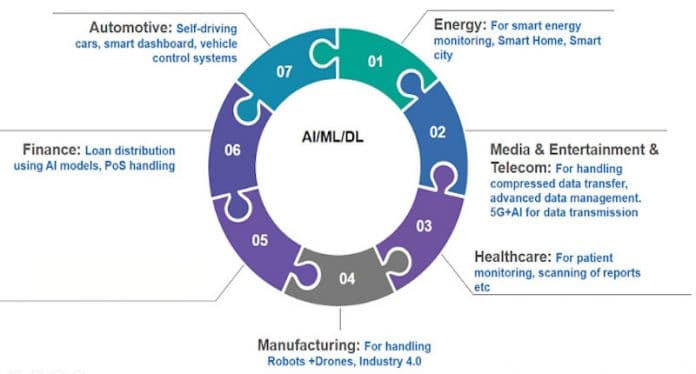Industry experts believe that advances in machine learning (ML) and deep learning (DL) algorithms will build new frontiers in AI. Since much of the world today depends on data, algorithms built around intensive data will play a major role. Lots of new developments in ML and DL based frameworks, like the latest releases of TensorFlow 2.0, Keras and Scikit-Learn, will help cope with the changes in this fast evolving domain.
The AI, ML and DL industry has been gaining lot of momentum of late. The latest developments in these fields are helping to solve many of industry’s challenges and problems. One only needs to know what combination of these technologies to apply and how to apply them. This article helps in applying these techniques based on the domain or the origin of the application.
Many of these developments help in building and providing the following:
- Advanced patterns based on data
- Deeper business insight
- Faster detection of anomalies
- Faster and better feature engineering
- State-of-art feature selection
- Synthetic data sets for building new models
- Best-in-class recommender systems
Industries that can use AI, ML and DL
The energy sector: This is one of the key sectors driving every type of industry. Optimum and efficient usage of energy is of utmost importance.
Many industries have IoT systems for monitoring and control. And the IoT+AI combination is implemented in many industry sectors. For example, the best time to switch on certain lights in office premises or manufacturing shop floors can be predicted based on analysing historical data using some well-known machine learning models. The quality of power too can be managed using AI models, which can be programmed in such a way as to provide fluctuation-free and uninterrupted power supply with optimum energy usage. The AI+IoT combination can also be used to maintain near rated voltages around 230V, constantly. The AI system considers many factors to optimise performance.
Managing smart cities using AI has become very popular. If each household can optimise its light usage or save energy while operating the various power consuming gadgets in the house, imagine how much power can be saved across the entire city.
Even in industries, smart energy initiatives along with AI+IoT can help in solving many challenges and optimising power usage.
Media and entertainment: This sector faces a number of challenges in audio, video and image processing, which can be addressed using advanced AI, ML and DL techniques. Volumes of data are being generated in the media and entertainment sector every day, either video or audio based. Transmitting this multimedia data consumes a lot of Internet bandwidth and also hampers the transfer rate.
Some techniques like advanced data compression can be used to make the transfer efficient and faster. IoT+ AI can be used on various data compression methodologies, which can be based on historical data for better prediction and usage. Also, by using AI, only the relevant data of the audio/video combination can be sent out. This selection is calculated independently using advanced AI algorithms, which saves a lot of bandwidth and also increases the transfer rate.
Healthcare: Managing and curing many diseases requires genetic algorithmic solutions. This sector is one of the key areas in which there is considerable ongoing development and advances in AI (especially DL).
In recent times, ‘decision support systems’ have been increasingly making use of AI technologies to assist clinicians. After analysing certain reports, faster decisions on diagnosing diseases and their causes can be made with the help of AI techniques. CNN based screening of X-ray images to classify various diseases is picking up. Also, image or non-image data of patients can be fused together to infer the clinical conditions of the patient. For example, in the ongoing COVID-19 pandemic, many AI based techniques are being used to screen patients, based on subtle features.
Manufacturing: Most manufacturing industries rely heavily on combinations of AI+ML+DL technologies. Even Industry 4.0 can be blended with AI technologies, for a smarter output and to better tackle industry-specific challenges.
The challenge of robot and drone co-ordination can be addressed using AI techniques. Both the robot and the drone can be individually controlled or instructed to handle or predict certain outcomes in the manufacturing industry. These can be used for handling or for preventing disaster situations.
Solutions like workflow optimisation and the division of labour (between machines and humans) require advanced AI algorithms and techniques. For OEM vendors of IoT (making the right choice of device at the right time, based on prevailing parameters), the latest AI techniques can be used for deciding which combination of IoT to choose.
Retail: The retail industry is one sector that serves the daily needs of many consumers. Traditional methods of shopping are time consuming and require a lot of human effort, but with combinations of AI + AR/VR and using virtual human-like avatars, multiple shopping experiences can be provided with real-time simulation of the shopping floor. Consumers get a mesmerising experience even while shopping in the comfort of their homes.
Telecom: Upcoming technologies like 5G are increasingly making use of AI for traffic shaping, congestion control and to ensure committed SLAs. Based on the type of data to be transferred, resources are allocated using AI algorithms (for prediction). The next big challenges like the seamless protocol or bulk transfer of data can be addressed using the AI+5G combination. This will help in solving most of the high-end data transmission challenges.
Automotive: The use of self-driving cars is expected to become more widespread. These autonomous vehicles use many of the AI features for predicting obstacles on the road, reading signboards, gauging the speed of oncoming vehicles and their direction, etc. All these identification processes have to happen in real-time to prevent any accidents.
Many of the latest vehicles are equipped with dashboards with advanced control systems built-in, and prediction and correction units. Also, warning systems are built based on the driver’s gestures, behaviour or posture. These will help in preventing many accidents. Figure 1 is a sample signboard, and Figure 2 shows how a computer reads it and makes predictions.
Finance: This is one sector that is continuously evolving and has to handle a lot of customer related challenges, which are not only human effort intensive but also time consuming. For example, when granting loans to certain customers, one has to manually examine their credit histories or backgrounds. But with a combination of AI technologies, client history or credit score data can be fed to machine learning models (AI systems) and later be used to make predictions. These predictive models can be built using historical data sets.
Which factors influence the sanctioning or withholding of loans or credit cards? Shown below are some of the sample variables or parameters considered for these predictions:
Loan_ID object Gender int64 Married int64 Dependents int64 Education int64 Self_Employed int64 ApplicantIncome int64 CoapplicantIncome float64 LoanAmount float64 Loan_Amount_Term float64 Credit_History object Property_Area int64 Loan_Status int64 LoanAmount_log float64 TotalIncome float64 TotalIncome_log float64
Using techniques like NLP (natural language processing) and ML, the disbursement of home or other loans can be done faster and more easily.
In many sectors, the PoS (point of sale) units in banks or financial markets are using AI systems or models. For the stock market, advanced AI algorithms are being used for better predictions or the purchase of shares and mutual funds.
AI and AR/VR
Artificial intelligence is playing a major role in the latest AR/VR technologies along with a combination of ML/DL algorithms. Simulated 3D shop floors, data centres for troubleshooting, and AR/VR based virtual shopping experiences are such examples. In these cases, the user gets to enjoy the exact replica or experience of the shop or lab based on the simulation. This is leading to easier and faster troubleshooting, and a better shopping experience.
The advances in GPUs and the CPU+GPU combination has helped in developing the latest real-world simulated games. This enthrals audiences because high performing gaming consoles are able to provide near real-time awesome experiences. The players of the game feel the ‘reality’ of being inside the stadium or auditorium where the games are being played.
Data and image processing
Most of the applications that we have dealt with are based on image processing, which either uses simple machine learning based algorithms or complex deep learning algorithms. Especially for data communication, compressed data saves a lot of bandwidth during transmission. It is quite a challenging task to identify the region of the image to be compressed and the technique to be employed. Many image optimisation techniques in CNN like filtering, max pooling, striding, sliding, etc, can be used. One of the key aspects is determining which video or audio file is to be compressed depending on the information present in that file or communication channel.
Nowadays, attention based data capture is one of the leading technological advancements in AI/ML/DL. This focuses users’ attention on the screens based on prior-selected options. For example, in simulated games like football or cricket, hand gestures or leg movements of the people playing the game are captured and fed into the on-screen game.
It is a challenging task if only certain portions of the image need to be extrapolated and searched for in a given context. This can be done by using optimised CNN techniques and methods; certain portions of the image only can be extracted and used for multiple purposes like search, matching, comparison, etc.
The cloud, the edge and fog computing
Allocation of resources is always a challenge and is a time consuming, tedious job — be it in a cloud environment or a container based microservices environment. CPU, memory and storage allocation have to be made in an appropriate manner as these are fully virtual environments.
Dynamic allocation of resources based on the importance and priority also plays an important role in any such environment. Various ML techniques like reinforcement learning can be applied for reward based decision making. This not only solves the problems related to the allocation of resources but also helps in appropriate allocation. These allocations can be based on reference goals and objectives.
Fog computing is the middle layer of a data network, where input from IoT networks is used for various intelligent decisions. A combination of IoT and AI help one to build robust fog computing networks.
Embedding intelligence into edge devices is now much in demand. Most of the emerging industrial applications need such autonomously built systems for HMI (human-machine interactions) and IoT combinations.
IoT
At present, millions of sensors are being added to the IoT ecosystem every year. The proliferation of IoT devices is happening at a very fast pace, posing a serious data challenge. In addition, the output value of these sensors is used for various purposes. Be it smart a home, smart energy meter, or smart manufacturing hub, if this data is not accurate and not validated properly, then this may lead to a disastrous situation. Even minute variations in this data can lead to an unwanted output or outcome.
The decisions taken based on this data need to be accurate, as they will influence later outcomes. Sometimes sensor devices produce wrong results for a short period of time due to unnatural events like insects covering the sensors at home, or a leaf or some object covering sensors installed outdoors. When multiple IoT devices are involved, selecting the sequence of devices to perform certain tasks is a challenge.
Various ML or DL algorithms and techniques are used to solve the above mentioned challenges.
- The output data collected during this threshold time is time series data, which is fed to the LSTM or ARIMA model to detect anomalies.
- KNN approach: With this approach the output data of sensor devices is verified with K-Nearest sensor devices. The distance between two sensor devices is measured using the location (x,y) values of both devices. This helps to classify the sensors in the correct group, and to categorise them properly.
- The combination of time series data and the output of various sensors can be used for identifying and distributing tasks to appropriate sensors.
This article can be used as reference material for building any AI, ML or DL model across industry sectors, in combination with other emerging technologies like IoT, AR/VR, etc.


















































































